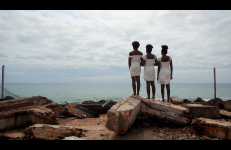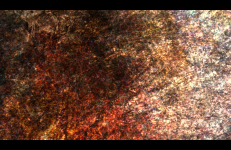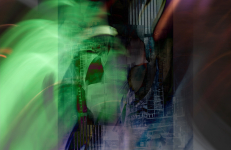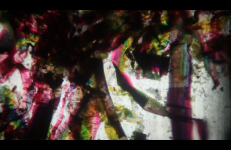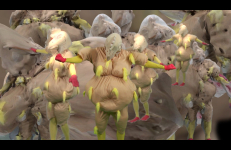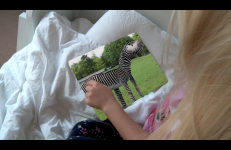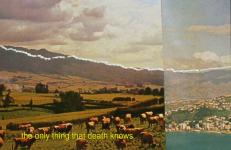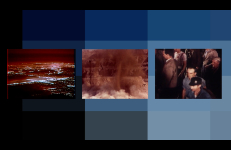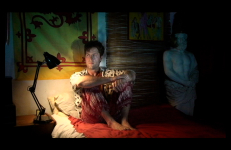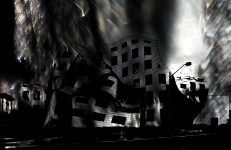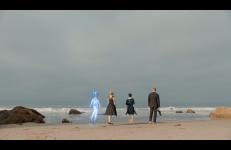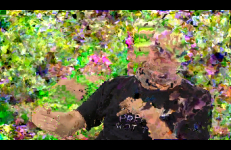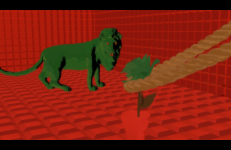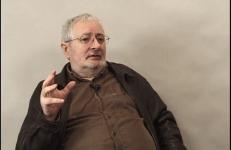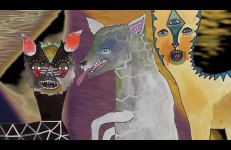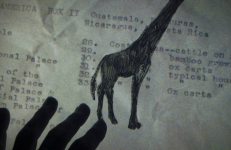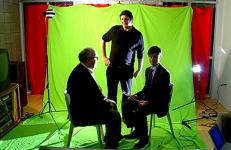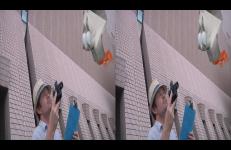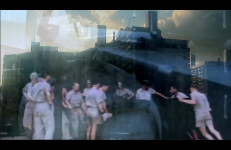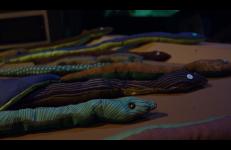In this interview, American filmmaker, teacher, and video artist Peggy Ahwesh (b.1954) delves into the key figures and primary texts that have inspired her work in Super-8 and video since the 1970s. She discusses her early influences as a member of the underground art scenes in Pittsburgh in the late 70s and Soho’s Kitchen in the 80s. Ahwesh’s experimental hand-processing and controversial subject matter can be traced to feminist theory, and her exposure to underground experimental films, including works by Werner Herzog, George Amaro, Kenneth Anger, Jack Smith and her teacher at Antioch College, Tony Conrad.
Philosophy
All that burns melts into air as “All that is solid melts into air” by Marx and Engels brings us to an imaginary of the present time marked by the reality and urgency of global warming.
Altamira is the paleolithic and post-human experience of the bloom of cinema. The cinema in a cave, the lightning of his presence, the fire of his birth. The paleolithic and post-human intermittence of the life of cinema. The sacred and contingent permanence of cinema. Part of the Hyperkinetic and Hauntology series.
A Kafkian vision of the New World. The arrival of Karl Rossman to the contemporary Babylon under the spell of the paranoid avant-garde. Kinetic coexistence of the archaic forms in dissolution.
This is the audiovisual translation of the Walter Benjamin's Theses on the Philosophy of History.
Two bizarrely costumed characters – a human ‘chicken’ in a fat suit, and an elaborate folksy creature called an ‘authenticity fetish’- meet and debate their plight. In an attempt to reconcile themselves with some unspecified trauma of mass biotechnoviolation, these two beings quiz one another in rhyme and animation on the origins and ontologies of their species. A sardonic meditation on the nefarious reality of intensive farming, Artificial Intelligence, and the perils of denying complexity.
Two characters speak urgently to camera about their relationship with an intelligent substance they call ‘Animal Expanded’. The man has swallowed it, as he expands it impregnates his home, improving his family. He holds his five-year-old up to camera: “Look how her fibers are formatting - she is her very own accelerated portfolio!” The woman has refused – "it’s not alive in the right way". For this disobedience she is punished with Confusion Events. But in her studio she is building new weapons, bizarre kinetic sculptures that she believes will "Re-align the narrative centre".
The horizon, where the sky and the earth meet, is always elsewhere, a promised place where these two elements come together. A metaphor, an orienting, a promise of transition, change, transcendence. A place where the corporeal and spiritual meet, or are cleaved apart.
In a guided meditation progress is posed as a godly icon for worship. The inseparability of the human labor-spirit connection is probed. On-screen text cites The Millennial Project: Colonizing the Galaxy in Eight Easy Steps, a 1998 book by Marshall T. Savage.
Is a person's soul 'real' in the 'material' world? ...Find out!
Photographer, theorist, and lecturer Victor Burgin lives and works in London. A Professor of Fine Art at Goldsmiths College and former Professor Emeritus of the History of Consciousness at University of California-Santa Cruz, Burgin’s work explores the semiotics of meaning in visual art. His books include The End of Art Theory: Criticism and Postmodernity (1986), In/Different Spaces: Place and Memory in Visual Culture (1996) and, as editor, Thinking Photography (1986), Between (1986) and Formations of Fantasy (1986).
A Kafkian vision of the New World. The arrival of Karl Rossman to the contemporary Babylon under the spell of the paranoid avant-garde. Kinetic coexistence of the archaic forms in dissolution.
Little Radek, the step-dancing Bolshevik; Machera, the Andean Robin Hood, and Maria Spiridonova, the Russian socialist assassin are your guides for Past Leftist Life Regression therapy. In this third Inner Trotsky Child video, narrator Lois Severin— a former Trotskyite turned suburban housewife—attempts to radicalize the personal fulfillment and self-help scene.
Contra-Internet: Jubilee 2033 is a re-imagining of scenes from filmmaker Derek Jarman’s 1978 queer punk film Jubilee, starring Susanne Sachsse and Cassils. Contra-Internet: Jubilee 2033 follows author Ayn Rand (Susanne Sachsse) and members of her Collective, including economist Alan Greenspan, on an acid trip in 1955. Guided by an artificial intelligence named Azuma, they are transported to a dystopian future Silicon Valley.
A modulation of the discourse produces a portrait of the philosopher Slavoj Žižek during a dialogue.
Distracted Blueberry follows a performance art band through a series of poetic encounters. Masculine tropes are undone to form a relationship between male sexuality and the human death drive. The body, violence and humour are positioned in the larger context of nothingness and somethingness, bridging a tension between externalized anxieties and the terrors of nature. Evocative of inner emotional states, strange landscapes exist as reflections of our shared dreams and nightmares.
Viewer discretion advised
In this interview, political and social theorist, Terry Eagleton (b. 1943), shares stories of his Irish upbringing and British education, and sums up his current engagement with art theory, leftist politics, and spirituality under capitalism. With reference to Henry James, Frederic Jameson, Christopher Hitchens, and Richard Dawkins, among others, this interview spans a vast landscape of literature and social theory.
The fourth collaboration between Jessie Mott and Steve Reinke continues its melancholic musings on desire and mourning, this time with more twerking. Hypnotic backgrounds and eccentric animals lend to its psychedelic children's cartoon vibe, and the signature Madonna and Stockhausen soundtrack enhances the desperation for paradise among those extra long tongues and snake-y bodies.
The fourth collaboration between Jessie Mott and Steve Reinke continues its melancholic musings on desire and mourning, this time with more twerking. Hypnotic backgrounds and eccentric animals lend to its psychedelic children's cartoon vibe, and the signature Madonna and Stockhausen soundtrack enhances the desperation for paradise among those extra long tongues and snake-y bodies.
Yon and Payola find themselves in a Victorian conservatory. They are companionable, disoriented and petulant––they whip wildly through these disembodied states. Payola reads an excerpt of their considerable tome on the age of enlightenment to Yon. Payola's research, and presentation of this research, is a purposeful affront to empirical data, the scientific method and other enlightenment ideals, while reveling in the desire for the revolution and intellectual expansion those thinkers championed.
An ordinary living room with a green screen, TV, and domestic cat serves as the backdrop for this DIY introduction to experimental philosophy. The president of a company is considering a vice president's moneymaking scheme. He says, "Look, I know this program will harm the environment, but I don't care at all about that. All I care about is maximizing profits. So let's start the program." The company adopts the policy, and sure enough, the environment is harmed. Now consider a seemingly straightforward question: Did the chairman of the board harm the environment intentionally?
Is Miley more or less happy than June Cleaver? Given very fragmentary information about the lives of two stereotypical figures with identical emotional states, people tend to give strangely asymmetrical evaluations of the two characters' propensity for happiness and unhappiness. An illustration of a controversial study called "The Ordinary Concept of Happiness (and Others Like It)".
An intrepid academic travels the world, asking people if it is OK for someone to stab a friend in order to test the sharpness of a knife. If one person says it's OK and another says it's not OK, can both respondents be right? This video is an illustration of a multi-layered experiment designed to test the claims of several traditional philosophers that non-experts (folk) tend to hold rigidly absolutist views of morality.
I Was There is a trilogy of experimental documentary films that explores the problem of radiation, our society's fading collective memory of the atomic bombing of Hiroshima and Nagasaki, and the unresolved debate between ethics and science. These series concern the immediate effects of weaponized nuclear technology, as invisible poison, on the human body.
In The Jungle playfully and sorrowfully tells the tale of an unreliable narrator in a self-imposed exile. Given a grant to study the equivalent of animal cries and whines in jungle flora our heroine has lived for 1,612 days deep in an unnamed jungle. This jungle serves as an extended metaphor for excessive and continual growth and death and fear and sustenance; a metaphorical space of chaos in which the scientist finds solace and which stands in contrast to the human jungle of 'civilization'.





